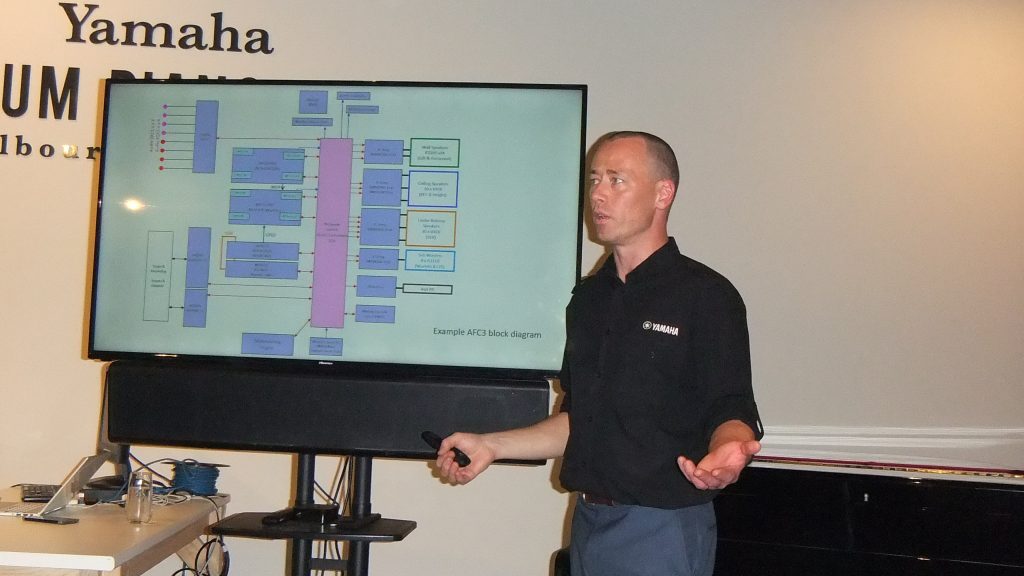Twenty one members and guests gathered in the Yamaha Premium Piano Centre (YPPC) in South Melbourne to hear Simon Tait explain the Yamaha AFC3 Active Field Control system and its use in acoustic enhancement and spatial audio applications.
Simon had recently installed an AFC3 system at this location and he was pleased to describe and demonstrate its features.
The evening started with a short live music performance (piano and clarinet), where Simon switched the system in and out to demonstrate the effect of the installed Active Field Control.

Following a brief biography, he then moved on to discuss the terminology of Active Acoustic Enhancement (AAE), commenting that it has been variously referred to as Active Architecture (AA), Assisted Reverb (AR), Electronic Acoustic Enhancement (EAE), or Active Field Control (AFC)

Simon went on to describe a short history of AAE, from Philips’ Ambiophony in the 1950s, through Lexicon’s LARES in the ‘80s, Meyer’s Constellation in the 2000s to today’s 3D convolution systems (Astro, LISA, Soundscape).
He then covered the basic topologies of AAE systems, describing the Regenerative, In-line and Hybrid configurations, commenting that the Yahamha AFC3, and the Meyer Constellation are both unique implementations of Hybrid Regenerative systems.
He then described the three system presets he had established in this venue’s system for demonstration purposes. A minor enhancement for general subtle improvement over the room’s “dryness”, a “voice lift” preset for more enhancement, and a “large hall” preset for an extreme indication of the systems capabilities. He then played some audio book content through a loudspeaker to be captured by the system’s microphones as if it was live speech. He switched between the presets to allow the audience to hear the effect of each preset.
He then described the system’s basic concepts – emphasising the importance of system stability and feedback minimisation in systems like this which employ live microphones and loudspeakers in a loop.
Simon went on to describe the benefits of deploying an AFC system, such as for improving the experience for the audience (the lecturer be heard so much better, soloist nuances are enhanced, and listener fatigue is reduced), for the performers (clearly hearing the ensemble, better audience responses), and for the business case (enhancing the multipurpose nature of the venue, it can be more sympathetically implemented in heritage venues, and is less expensive than purely mechanical solutions).
He then covered the process of implementing an AAE system, and covered the design criteria and design inputs, which lead to a specific system architecture. He went on to discuss the decision on the number of speakers and microphone deployed, which then drives the rest of the design (amps/dsp etc).
In
this context he described the AFC setup at the YPPC in some detail,
and went on to display and comment on an example AFC3 block diagram,
covering all the key elements.
He commented that the use of
Dante Audio over IP was the only practical way to implement such
systems – due to inherent large size of such systems, usually
running to hundreds of crosspoints.
He then discussed the installation, commissioning and tuning of the systems in some detail.
At the conclusion of the AFC presentation he took several questions from the floor, covering both the system’s operation and his experience in setting up his first AFC system.
Simon then moved on to discuss Spatial Audio and how it can be realized from within an AFC system.
He described the wavefield synthesis method of rendering spatial audio. Using descriptive slides he covered the basic principles of wavefield synthesis, and listed the various live applications available. He then covered the basic design considerations, like loudspeaker spacing, and the size of the venue, commenting that very large spaces run into time-of-flight issues and are unsuited to wavefield synthesis.
He then revisited the AFC system block diagram, pointing out where a spatial audio rendering engine can be incorporated into the AFC system to add spatial cues to the audio – and played a recorded music example of spatial audio. He also described some considerations of sound design in spatial audio (like making objects mono, not stereo to simplify the design), and gave a quick description of the Soundscape Renderer software he uses for creating spatial audio designs.
He then described a recent spatial audio project – The Yamaha/MPavilion “Space and Sometimes Movement” spatial rig.
Finally, he presented a list of online publications from Yamaha, the AES E-Library, and other sources (listed below).
A Q&A session followed, covering a range of spatial audio and AFC topics, including a discussion on the possibility of potential consumer applications of AFC.
We thank Yamaha Music Australia for hosting the night, and Simon for a most interesting and informative presentation.
This video (posted on YouTube) consists of an audio recording married to the slides presented.
Simon’s slides can be viewed or downloaded here.
An audio recording of Simon’s presentation can be heard or downloaded here.
(The music and audio-book demo sections have been truncated)
Further Reading:
General AAE Information:
https://au.yamaha.com/en/products/proaudio/afc/afc3/downloads.html
General WFS Information:
http://www.aes.org/e-lib/browse.cfm?elib=14488 (co-written by the Soundscape Renderer guys)
http://www.aes.org/e-lib/browse.cfm?elib=16663
SA
Software Packages (Do a Google Search on these):
FREE
& Open Source – Soundscape Renderer (Github) / SPAT for MAX.MSP /
WFSupercollider
Proprietary: d&b Soundscape / L’Acoustics LISA / BARCO IOSONO / Astro Spatial
Space
& Sometimes Movement event Feb 2019:
Latest
issue of Audio Technology Magazine (March 2019)
